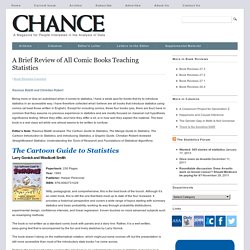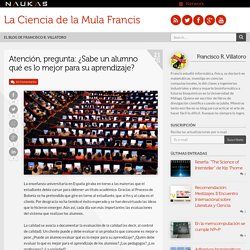

10691898.1995. 1.

Introduction 1 Very often teaching and learning statistics at university seem to be activities directed primarily to students' passing assessments and gaining paper credentials. This tends to be the case especially in service courses, where, indeed, the vast majority of statistics students are found. Once such an orientation becomes entrenched, longer term objectives may be regarded by teachers or students (or both) as unattainable. La teoría de las inteligencias múltiples a examen. La teoría de las inteligencias múltiples (IM) sostiene que las habilidades cognitivas están divididas originalmente en siete inteligencias que operan de forma independiente desde diferentes áreas del cerebro (Gardner, 1983).

Son las siguientes: lógico-matemática, lingüística, interpersonal, visual-espacial, musical, corporal-cinestésica e intrapersonal. RitaPierson 2013S 480p es. Neurocrap. …and why it survives Paul A.

Kirschner & Mirjam Neelen In the past few decades, myths about our brains and their functioning – so called neuromyths – have been born, been propagated and have stubbornly lived on. In schools and higher education institutions as well as in the workplace, this ‘neurocrap’ seems to persist and is used to justify a mass of ineffective instructional or learning approaches. Howard-Jones stated in his recently published article in Nature Reviews Neuroscience: “Imagine that brains are active for only 10%, shrink if you do not drink 6-8 glasses of water per day and that the communication between the two brain halves can be stimulated by massaging two invisible buttons on your chest”.
What teachers make. When will I use math? What Sir Ken Got Wrong. “We are educating people out of their creativity” Sir Ken Robinson Sir Ken Robinson’s ideas on education are not only impractical; they are undesirable.

If you’re interested in education, at some point someone will have sent you a link to a video by Sir Ken Robinson, knighted for services to education in England in 2003. He has over 250,000 followers on Twitter, his videos have had over 40,000,000 views online, and his 2006 lecture is the most viewed TED talk of all time. The RSA Opening Minds curriculum his ideas are associated with is taught in over 200 schools in the UK. What's the best teaching method? Seventy teachers from the UK were sent to Shanghai to study classroom methods to investigate why Chinese students perform so well.

Upon their return, the teachers reported that much of China’s success came from teaching methods the UK has been moving away from for the past 40 years. The Chinese favour a “chalk and talk” approach, whereas countries such as the UK, US, Australia and New Zealand have been moving away from this direct form of teaching to a more collaborative form of learning where students take greater control. Given China’s success in international tests such as PISA, TIMSS and PIRLS, it seems we have been misguided in abandoning the traditional, teacher-directed method of learning where the teacher spends more time standing at the front of the class, directing learning and controlling classroom activities.
Direct instruction vs inquiry learning. On Pi Day, a serving of why we need math. Posted: Friday, March 13, 2015, 1:08 AM By Darren Glass On Saturday, our Facebook feeds will be peppered with references to Pi Day, a day of celebration that has long been acknowledged by math fans and that Congress recognized in 2009.

Every high schooler learns that pi is the ratio of the circumference of a circle to its diameter and that its decimal expansion begins 3.14 and goes on infinitely without repeating. Mathematicians love pi because there are many interesting facts surrounding it. Other people seem to get a kick out of dates that demonstrate patterns. 20150204_23865.jpg (JPEG Image, 1348 × 917 pixels) - Scaled (75%) Técnicas de demostración para casos ‘desesperados’ ¿Has olvidado la forma de demostrar un resultado en mitad de una exposición?

¿No has tenido tiempo de preparar tu clase? ¿No entiendes la prueba de un enunciado y debes contárselo a alguien? No te preocupes, lee estos consejos, alguno puede serte útil. Algunas técnicas de demostración (para casos desesperados) Prueba basada en un ejemplo: Se demuestra el caso n=2 y se argumenta afirmando que esta prueba contiene las ideas fundamentales de la demostración general.Prueba por generalización: “Funciona para el número 17, por lo tanto, funciona para todo número real”.Prueba por intimidación:Es trivial.Prueba por omisión: “Los otros 253 casos son análogos. Trabajadores de la Educación Superior, no casta. EN el momento de escribir estas líneas, las reacciones a la modificación de la estructura de las enseñanzas universitarias copan los medios.

Pero más allá del revuelo mediático que ha suscitado el 3+2, conviene recordar que en los últimos meses han corrido ríos de tinta sobre la Universidad. Teach Yourself Programming in Ten Years. Socratic - Get smarter together. Eco portal. A Brief Review of All Comic Books Teaching Statistics. Rasmus Bååth and Christian Robert Being more or less an autodidact when it comes to statistics, I have a weak spot for books that try to introduce statistics in an accessible way.

I have therefore collected what I believe are all books that introduce statistics using comics (at least those written in English). Except for including comics, these four books (yes, there are four) have in common that they assume no previous experience in statistics and are mostly focused on classical null hypothesis significance testing. Where they differ, and here they differ a lot, is in how well they explain the material. The best book is a real class act while one almost seems to be written to confuse. Editor’s Note: Rasmus Bååth reviewed The Cartoon Guide to Statistics, The Manga Guide to Statistics, The Cartoon Introduction to Statistics, and Introducing Statistics, a Graphic Guide. The Cartoon Guide to Statistics. ¿Una casta universitaria? Buenos profesores malas calificaciones. Atención, pregunta: ¿Sabe un alumno qué es lo mejor para su aprendizaje? La enseñanza universitaria en España giraba en torno a las materias que el estudiante debía cursar para obtener un título académico.

Gracias al Proceso de Bolonia se ha pretendido que gire en torno al estudiante, que al fin y al cabo es el cliente. Por desgracia no ha tenido el éxito esperado y se han desvirtuado las ideas que lo hicieron emerger. Aún así, cada día son más importantes las evaluaciones del sistema que realizan los alumnos. Plastilina. Audience Response Systems. Bolonia y la docencia de los poetas muertos. Robin Williams acaba de morir. Descanse en paz. Www.cogtech.usc.edu/publications/kirschner_Sweller_Clark.pdf. Guy's Econometrics blog: XtransX to the minus one X transpose Y. Ben Lambert. Upload Subscription preferences Loading... Working... Ben Lambert Introduction to econometrics 12,842 views 10 months ago This video provides an introduction to the undergraduate and graduate level courses, providing an overview of the syllabuses.
Spreadsheet Addiction. Some people will think that the “addiction” in the title is over the top, or at least used metaphorically. It is used literally, and is not an exaggeration. Addiction is the persistent use of a substance where that use is detrimental to the user. It is not the substance that is the problem — more limited use may be beneficial. It is the extent and circumstances of the use that determine if the behavior is addictive or not. Spreadsheets are a wonderful invention.